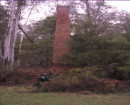ORIENTAL SLUICING CLAIMS
ORIENTAL CLAIMS HISTORIC AREA AND GREAT ALPINE ROAD OMEO, EAST GIPPSLAND SHIRE
-
Add to tour
You must log in to do that.
-
Share
-
Shortlist place
You must log in to do that.
- Download report
Statement of Significance
The Oriental Claims Hydraulic Gold Sluicing Site consists of a vast network of sluicing faces, pebble dumps, tail races and water races. Water for sluicing would have been delivered to the site by high pressure pipelines and then directed at the gold bearing deposits. The technology was introduced into Victoria in about 1855. The name for the Historic Area comes from the name of a sluicing company which worked the area from 1876-1904; but the term also acknowledges the significant contribution of Chinese miners to the area's history.
The Oriental Claims Hydraulic Gold Sluicing Site is of historical, archaeological and scientific importance to the State of Victoria.
The Oriental Claims Hydraulic Gold Sluicing Site is historically and scientifically important as a characteristic and well preserved example of an early form of gold mining. Gold mining sites are of crucial importance for the pivotal role they have played since 1851 in the development of Victoria. Hydraulic sluicing of alluvial gold deposits is an important key ingredient in an understanding of gold mining technology as it was employed in country where water was plentiful and perennial.
The Oriental Claims Hydraulic Gold Sluicing Site is archaeologically important for its potential to yield artefacts and evidence which will be able to provide significant information about the cultural history of gold mining and the gold seekers themselves.
[Source: Victorian Heritage Register.]
-
-
ORIENTAL SLUICING CLAIMS - History
Heritage Inventory History of Site: The Oriental Claims Historic Area encompasses a number of sluicing claims worked on a large scale in the Dry Gully area between 1855-1904. The name ‘Oriental’ comes from the name of a sluicing company which worked the area from 1876-1904; but the term also acknowledges the significant contribution of Chinese miners to the area’s history.Champagne and Co. was the first party to establish a claim on the ground, in 1855, and they constructed a long sluicing race to feed their ground sluicing operations. In 1857, Fitzgerald and party took up ground they called the Pioneer claim at the junction of Livingstone Creek with Dry Gully and Mountain Creek. Fitzgerald gained a virtual monopoly on water supply—and, in effect, on sluicing—by taking up agricultural ground around Dry Hill and west of Livingstone Creek, preventing rival parties in the vicinity from constructing water races to their claims.Early sluicing claims were worked using sluice boxes and Californian pumps and wheels. The Pioneer Co.’s extensive water races enabled it to graduate to hydraulic sluicing in the early 1870s. The use of the high-pressure hose allowed the processing of far greater quantities of washdirt, and this was the first operation of its kind in the district. The high-pressure jet of water was trained on the lower section of a high face, undermining the upper section and causing it to collapse, thereby delivering massive amounts of washdirt to the sluice boxes with relatively little effort. In 1876, the Oriental Sluicing Co. was formed (the pioneering Champagne was a partner) to work ground south of the Pioneer claim by hydraulic sluicing. The company intended cutting a six-mile water race up the Livingstone Valley to their claim, but Fitzgerald objected to it crossing his private property, the only practicable route. Completion of the race was delayed until the introduction of the Mining on Private Property Act in 1884.In 1883, Fitzgerald and Co. sold the Pioneer claim to a party of Chinese for £1,000. In its first 25 years of operation, the claim had yielded an estimated 7,500 oz of gold. Under its new ownership and following a drought in the early 1880s, the Pioneer claim never regained its old vigour. By 1886, the Oriental Co. was in full operation at last and on its way to being the premier gold producer of the district. Its contentious water race was complete and capable of supplying water enough for two hydraulic hoses and twelve 36-inch sluice heads. In 1889, the Oriental Co. installed a Giant hydrant and nozzle—the latest sluicing technology—in the hope of doubling its gold production. The tail-race was deepened and extended to 600 feet in length. High-pressure water was delivered to the sluicing site through a line of iron pipes which gradually reduced in diameter—from one foot, to nine inches, to six inches, to a hose nozzle of only two or three inches’ diameter. The result was the best yield for years.The Oriental Co. continued operating until 1904, when the Sludge Abatement Board halted all sluicing on Livingstone Creek. The company’s total gold production was estimated at 12,500 oz, and other sluicing claims in the vicinity were thought to have yielded about 21,000 oz since 1857. Griffiths put the total production of the Oriental claims at close to 42,000 oz (or an average 5 grain per cubic yard), which made them ‘without a doubt the largest and most profitable sluicing venture in Gippsland’.In 1911, a new Oriental Co. took up the old ground and installed new, up-to-date sluicing plant. A 120-foot face was sluiced, with the tailings deposited on ground already worked, so as not to pollute the creek. Low yields forced operations to cease within a year.ORIENTAL SLUICING CLAIMS - Interpretation of Site
Nineteenth century and 1930s hut sites have been identified within Oriental Claims VHR site and indicate that the heritage site is more extensive than originally recorded.
Heritage Inventory Description
ORIENTAL SLUICING CLAIMS - Heritage Inventory Description
15/05/2020 submitted site card: See existing site card H8423-0001. Additional nineteenth century and 1930s hut sites have been located within the Oriental Claims VHR area (Figures 6 and 7). The Oriental Claims comprises the remains of gold mining activities from a number of periods relating to both the hydraulic sluicing operations of the late nineteenth and early twentieth centuries and earlier alluvial mining activity. Mining remains comprise water races, sluiced cliff faces, mullock heaps and stacked rock piles, drains, tracks and hut platforms, sometimes with evidence of brick or stone chimneys and occasional small artefacts such as glass and ceramic fragments. Features at Oriental Claims and surrounds comprising the following: • Water races, tail races, drains and creek diversions • Gold workings and puddling site • 1930s Hut and rock wall sites • Hut and water races • Chinese ceramics, stone walls and dump sites Among the various groups and individuals who undertook mining in this area are the following: • Pioneer Claim 1856-1888 • Ah Look’s Claim 1869-? • Ah Fong’s Claim, 1875-1883 • Oriental Claim 1876-1888, 1888-1905 • Ah Fie’s Corea Claim 1894-1906 • Ah Fong’s claim, Ah Fie’s Omeo Sluicing Claim 1875-1883, 1893-1919 • Ah Sam and Lye Fook’s Starlight Claim 1893-1902, 1902-1921 Picnic area - large picnic area established near northern end of sluicing dam with interpretation trail running from picnic area to northern section of sluicing works. Northern end of sluicing works - vast sluice hole with sheer face up to 30m in height, extensive system of tail races, scattering of stacked pebble dumps. Southern end of sluicing works - contains a network of paddocks stacked pebble dumps and tail races linked to major drain channels.Heritage Inventory Significance: National EstateScientific significanceùextent and intactnessNetwork valuesù?Natural valuesùaltered landscapeVHR STATEMENT OF SIGNIFICANCEThe Oriental Claims Hydraulic Gold Sluicing Site consists of a vast network ofsluicing faces, pebble dumps, tail races and water races. Water for sluicing would have been delivered to the site by high pressure pipelines and then directed at the gold bearing deposits. The technology was introduced into Victoria in about 1855. The name for the Historic Area comes from the name of a sluicing company which worked the area from 1876-1904; but the term also acknowledges the significant contribution of Chinese miners to the area's history. The Oriental Claims Hydraulic Gold Sluicing Site is of historical, archaeological and scientific importance to the State of Victoria.The Oriental Claims Hydraulic Gold Sluicing Site is historically and scientifically important as a characteristic and well preserved example of an early form of gold mining. Gold mining sites are of crucial importance for thepivotal role they have played since 1851 in the development of Victoria. Hydraulic sluicing of alluvial gold deposits is an important key ingredient inan understanding of gold mining technology as it was employed in country wherewater was plentiful and perennial.The Oriental Claims Hydraulic Gold Sluicing Site is archaeologically importantfor its potential to yield artefacts and evidence which will be able to provide significant information about the cultural history of gold mining and the gold seekers themselves.
-
-
-
-
-
ORIENTAL CLAIMS HYDRAULIC SLUICING SITE
 Victorian Heritage Register H1225
Victorian Heritage Register H1225 -
ORIENTAL SLUICING CLAIMS
 Victorian Heritage Inventory
Victorian Heritage Inventory
-
-







